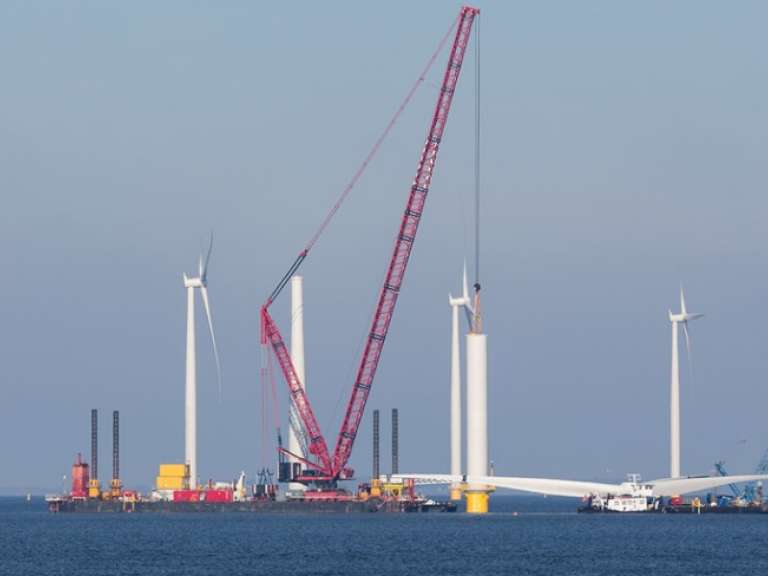U.S. Offshore Wind Is Coming to the East Coast
Peter Kelly-DetwilerFollowing in Europe's footsteps, U.S. offshore wind is poised for a boom, benefiting from declining costs and improving technologies.

Get ready for the rapidly emerging U.S. offshore wind industry. Last December marked a major milestone for U.S. renewable energy policy, as Deepwater Wind's five, 6-megawatt (MW) turbines started spinning off the coast of Block Island, RI. After years of planning, the Deepwater Wind team had to surmount numerous obstacles to complete the project. When the project was first conceptualized in 2006, the enormous turbines that are now deployed did not even exist yet, and U.S. offshore wind was little more than an idea.
Since that time, the industry has matured considerably, driven largely by technology advances in Europe. Today, almost 3,600 turbines, averaging 4.8 MW and as large as 8 MW, can be found in Europe's waters. According to Wind Europe, new offshore installations in 2016 resulted in 1,558 MW with a total installed offshore capacity exceeding 12,631 MW and supplying 10 different countries. Another 4,800 MW of projects are under construction.
Subsidies have helped, but so has experience and the growing economies of scale associated with pipelines in the thousands of MWs. While still about 50 percent more costly than onshore wind, offshore wind costs are falling quickly, promising future growth.
With the successes in Europe, many global players are now turning their eyes to the budding U.S. offshore wind markets, where the potential prize is huge. In fact, the U.S. Office of Energy Efficiency and Renewable Energy states that data on the technical research potential suggest more than 2,000 gigawatts of offshore wind could be accessed in the Great Lakes and off the coast of the United States.
To that end, Clean Technica reports that the Department of the Interior's Bureau of Ocean Energy Management (BOEM) created a national strategy to exploit the resource. Among other activities undertaken to hasten the wind development process, the BOEM created a regulatory and leasing framework, approving areas for future wind development. This has been a successful approach. Over 1,200,000 acres off the East Coast have already been leased out in competitive bids to private companies.
These leases are only increasing in value. In late 2016, a Statoil subsidiary bid over $42 million for a single lease—more than double what was paid for the prior 11 U.S. offshore wind leases combined, the National Resource Defense Council reports.
Following on the heels of the Block Island farm, other U.S. offshore wind projects are already in the works. Deepwater Wind plans to start construction as early as 2019 on a 90-MW offshore facility in Long Island, NY. The related power contract has already been approved, and the Long Island Power Authority has committed to purchasing energy for 20 years. Deepwater is also eyeing a site further offshore with the potential for over 1,000 MW of wind energy.
Meanwhile, global offshore wind leader DONG Energy is teaming up with transmission-builder Eversource Energy to develop a site 15 to 25 miles south of Martha's Vineyard off Massachusetts. DONG Energy already has 25 years and over 1,000 offshore turbines under its belt, poising it for success in the U.S. According to DONG, this single Massachusetts location has the potential to yield over 2,000 MW of power.
The resources are available and the developer interest is clear. Massachusetts formally committed to buying 1,600 MW of offshore wind by 2027 with the procurement process beginning in June of this year. Not to be left behind, the New York State Energy Research and Development Authority reports that Governor Andrew Cuomo has committed to developing up to 2,400 MW of wind resources off New York's coastline—the largest U.S. commitment to date.
Infrastructure is a critical element, as well. Massachusetts spent tens of millions of dollar early in the decade refurbishing the port of New Bedford to support the industry, according to Forbes. The state built a 1,000-foot extension to the existing bulkhead and reinforced it to withstand two tons of pressure per square foot, in addition to dredging the channel to enable large ships to handle the associated blades and turbines.
The last piece of this offshore wind puzzle is the development of the nascent U.S. supply chain. In the early days, blades and turbines will largely be imported from European companies or U.S. companies' European subsidiaries. Once commitments for approximately 2,000 MW in the pipeline are made, local supply chains will become more established.
The eastern United States is now beginning to see that pipeline fill up. Today, over 100,000 workers have jobs in the U.S. onshore wind industry. Texas alone has 22,000 wind-related jobs and 40 manufacturing facilities. Within a few years, we are likely to see the experience from Europe transplanted across the sea to our own shoreline. This is an exciting time for the power industry, as a new frontier for offshore wind is rapidly developing on our doorstep. Offshore wind will bring thousands of new jobs and prosperity, as an entirely new industry establishes itself along the coast of the United States.
The future of gas generation will by shaped by its relationship to renewables, regulations to keep costs down, and new drilling technologies.
Wind power generation and solar can be integrated into the grid with optimal power generating models and flexible conventional generation.
Power plant managers should keep watch for energy industry trends in 2017: rise of distributed generation, fuel mix changes, digital technology, and more.